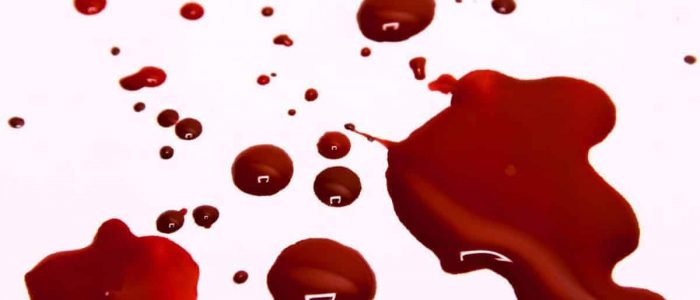Blood is one of the most difficult substances to eliminate due to its protein composition, and even more so, the longer we allow it to dry.
Well when we have an injury, get injured or suffer some kind of accident, it is very likely that we find ourselves in a situation that requires some simple tricks to be able to completely eliminate this stain without leaving a trace.
Blood stains are generally very complex to remove, so we leave a series of common recommendations for blood in any type of tissue:
- First of all, the garment should be rinsed with cold water so that the stain softens and is easier to extract.
- Not to heat. Avoid heat and hot water, as this will cause the stain to expand.
- Never mix ammonia and bleach, as they are highly toxic.
- Do not use the dryer under any circumstances as the heat could set the stain permanently and it would be impossible to remove.
- Always wear gloves to protect your skin.
- Remove the stain as soon as possible after it has occurred. The longer it is left, the more difficult it will be to clean.
How to remove blood stains from different surfaces
Stains on the floor. For different types of flooring it is easy to remove the blood using any detergent or soap with cold water. If the blood has dried and remains resistant, you will need to use a little bleach.
Wood. For wood we should not use strong products, since it can be damaged by chemical products, for them we will use a little cold water and soap. Then we will dry it and apply a little wax to make it look like new.
Stone. The stone should be cleaned with a sponge moistened with cold water. In case it resists, we will apply a layer of powdered detergent and a little chlorine, allowing it to act for 5-10 minutes. Once the stain has disappeared, it should be rinsed well and dried with a cloth. If there is any remaining blood, it can be rubbed lightly with a stiff bristle brush to achieve a better result.
Plaster or cement We will clean with a damp sponge, removing as much blood as we can. Next we will use a toothbrush dipped in water and a little baking soda or powdered cleaner and rub lightly. Then we will rinse it well and let it dry.
Carpets and rugs. For this type of synthetic fabrics, the following steps must be followed:
- Step1: apply a tablespoon of detergent and a little cold water to the stained area and leave for a few minutes.
- Step 2: Lightly massage with a cloth until it has disappeared.
- Step 3: In case the blood persists, add a tablespoon of ammonia and rub gently with a sponge. Repeat the process until there is nothing left.
- Step 4: dry with an absorbent cloth.
Wall paper or wallpaper. In the case that it is washable paper, we will use a sponge with cold soap or detergent water and a few drops of ammonia rubbing until the entire stain is eliminated. In the case of non-washable papers, they should be cleaned with starch and water and allowed to dry for a few minutes. Then it is given with a brush until the blood comes out completely.
Skins For this genre we must be extremely cautious since carelessness can spoil our garment.
First of all, we must remove as much blood as possible with a cloth. Then we will moisten a cloth with detergent or soap and a few drops of bleach. Rub delicately trying not to damage the hair. Then we will remove the soap with cold water until it is completely clean. Finally it should be put in the sun and let it dry.
Leather. For this type of skin we will mix a little mild soap or detergent in cold water generating a large amount of foam. Apply with a sponge directly to the area and rub until completely removed. Afterwards it will be dried with a soft cloth.
Silver. We will wash the silver in hot soapy water. We will rinse it with hot water and then we will dry it gently so that it is impeccable.
Non-washable garments. Garments such as wool, silk, rope, etc. They should be washed with a sponge rubbing with cold water, if it persists, we will apply a cleaner and a few drops of ammonia. Then we will place a damp absorbent pad and let it act for a short time. Once removed, we will rinse it completely with cold water, eliminating all traces of ammonia. Then we will dry with a cloth and leave it in the sun to finish.
Washable garments. These garments are easier to remove stains such as fabric, cotton, fabric, polyester ... In general, they can be removed with a simple deep wash with cold water, if the stain persists it should be washed in cold water with detergent or soap and a few drops of ammonia. Then brush gently with a stiff bristle brush, taking into account the type of fabric. Rinse and remove all traces of ammonia. Once it is dry, it is washed again in the washing machine and left to dry in the sun.
11 methods to completely remove blood stains
There are many types of methods against this liquid, from the use of detergents and soaps for clothes, vinegars, bleaches to stain whiteners, taking into account the type of fabric on which we act.
Method 1
The first method is to remove the blood while it is still wet.
- Step 1: Rinse the fabric with cold water. This is one of the simplest ways to eliminate blood that is not dry and it is important not to use hot water so as not to impregnate the fabric. It is applied just after it has been stained to remove any traces.
- Step 2: Hydrogen peroxide. This product is a bit aggressive so we have to take into account the type of fabric, since hydrogen peroxide can bleach or damage the garment. In this way we will apply the hydrogen peroxide on the stain, diluting it, in turn, with a little water to avoid that the product is not so strong. Once cast, it should be rubbed gently with a cloth. Once this step is completed, wash the garment with soap and cold water.
Your garment will be clean as if nothing had happened.
Method 2
The second method is for delicate fabrics is to use salt and water. Salt is very effective on porous surfaces and is great at preventing blood from sticking to tissue. This method is very useful on items that are too large for the washing machine, such as mattresses.
It is based on putting the stain under a stream of cold water. If it is a carpet or furniture, put ice and water on a cloth or cloth and place it on the affected surface. Then erase the stain with a sponge or dish towel. Wait 10 minutes and then add a little salt. The properties of the grains of salt will loosen the remains of blood and remove it from the fibers.
When it has completely disappeared or can no longer come out, wash the garment with cold water and detergent
Method 3
Use soap that we normally use for the bathroom. This form is similar to salted water, you can use soap or shampoo directly. It is very useful for carpets, blankets and floors.
First, cold water is applied to the stain, the colder the water, the more effective it will be. Then add soap or shampoo to the area, rubbing vigorously with a wet cloth. If too much foam forms add more water. Finally rinse with cold water and repeat this process two or three more times until the stain disappears completely. Once finished, wash, if possible, with water and detergent.
Method 4
The dreaded ammonia. If the stain is terribly difficult to remove, apply this product. First mix a tablespoon of ammonia with ½ cup of cold water and pour it over the area. When the stain has disappeared, it should be rinsed with cold water. It is important not to apply this substance on delicate surfaces.
Method 5
Saliva as an ally. Saliva can be really effective due to the enzymes it contains and that help digest nutrients, since they have the ability to break down the proteins in the blood that make the cleaning process so complicated.
It is done by applying saliva directly on the stain and rubbing intensely with a little cold water. Repeat the process several times until it is completely removed. Then wash the fabric with cold soapy water.
Method 6
Lemon and sun. With this method, you have to wait until the garment has dried to see that there is no trace of blood. It should be avoided in textures such as silk, linen and lycra, taking into account that the acidity of citrus can damage the fabric.
- Step 1: First, soak in cold water for a few minutes. Drain it ensuring that it is only damp.
- Step 2: Put it in a zip-lock bag.
- Step 3: Add two cups of lemon juice and half a cup of salt into the bag and then close it.
- Step 4: With the bag completely closed, massage with your hands, pressing hard on the stained area so that the liquid penetrates and removes all the blood particles.
- Step 5: Leave the garment in the bag for 10 minutes, letting the lemon and salt act.
- Step 6: Take out the fabric and spread it out, letting it dry in the sunlight. It is important not to use stoves or radiators, only with the sun it will dry out.
- Step 7: Once this process is finished, wash the garment with cold water and detergent.
Method 7
Toothpaste. This process is the most recommended in fabrics that can be washed by hand or in the washing machine, it is usually used for curtains, tablecloths and rugs.
The process consists of applying toothpaste on the stain and then adding a little cold water with some kind of container. Afterwards, the paste is rubbed vigorously so that it takes effect and does not leave any type of particles. Finally, wash the fabric in a program of cold water and soap, or wash by hand.
Method 8
Meat tenderizer against blood. Blood is an organic product like meat, so it is quite effective to use this type of product due to the action of enzymes. They are especially effective on dried blood stains. They are highly aggressive so it is not recommended to use them on sensitive surfaces such as wool, silk or linen.
- Step 1: Pour cold water on the stain.
- Step 2: Add a tablespoon of meat tenderizer.
- Step 3: Rub on the wet surface.
- Step 4: Leave to act for a maximum of 1 to 2 days.
- Step 5: Wash with cold water and detergent.
Method 9
Powdered starch. Starch is a powerful stain remover of this type. It is based on applying a little of this and leaving it to act between 1 and 3 minutes. Then rub with cold water and then wash with water and detergent.
Method 10
Aspirin or vinegar. Due to the acidic substances they contain, they can dissolve blood stains. They are usually not very aggressive so the fabric is not damaged.
Method 11
Chlorine. Chlorine is a powerful blood solvent but special care must be taken, as it can have negative effects on the garment, so it should not be applied directly. A plug of bleach is diluted with cold water and the fabric is allowed to soak for 15 minutes. White clothing should not be mixed with colored clothing, as the mixture can cause it to discolor a bit.



